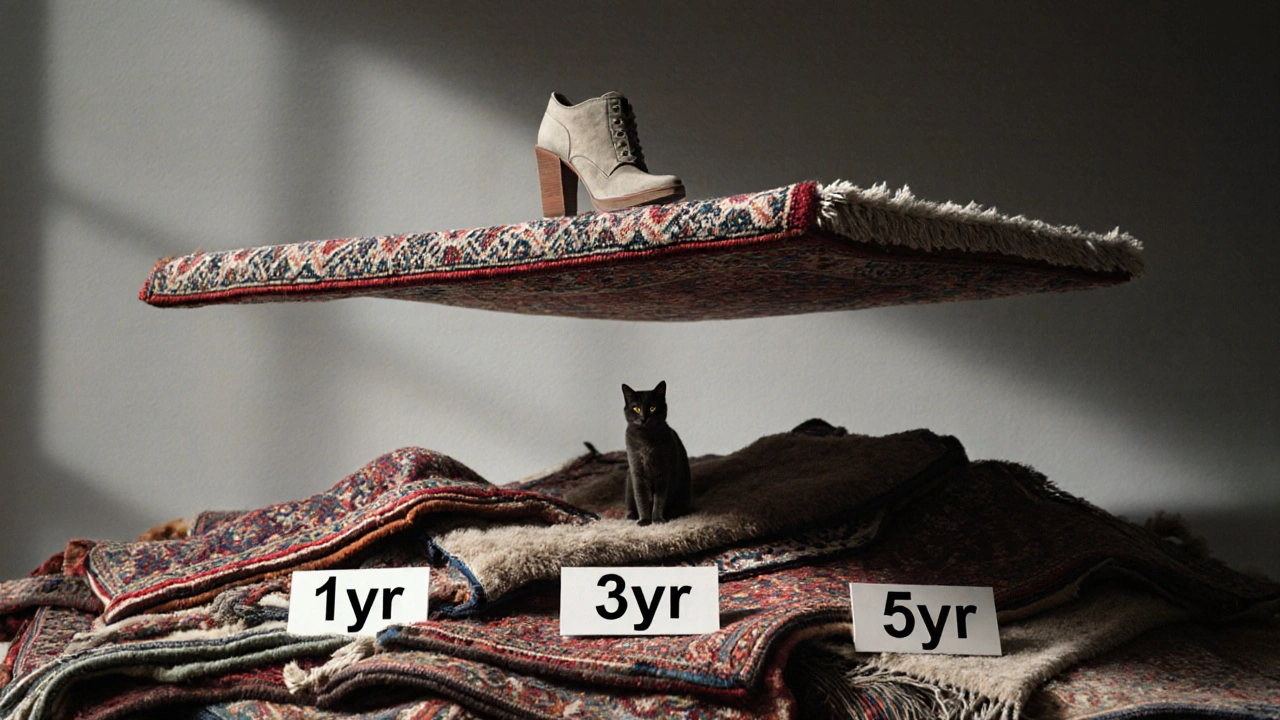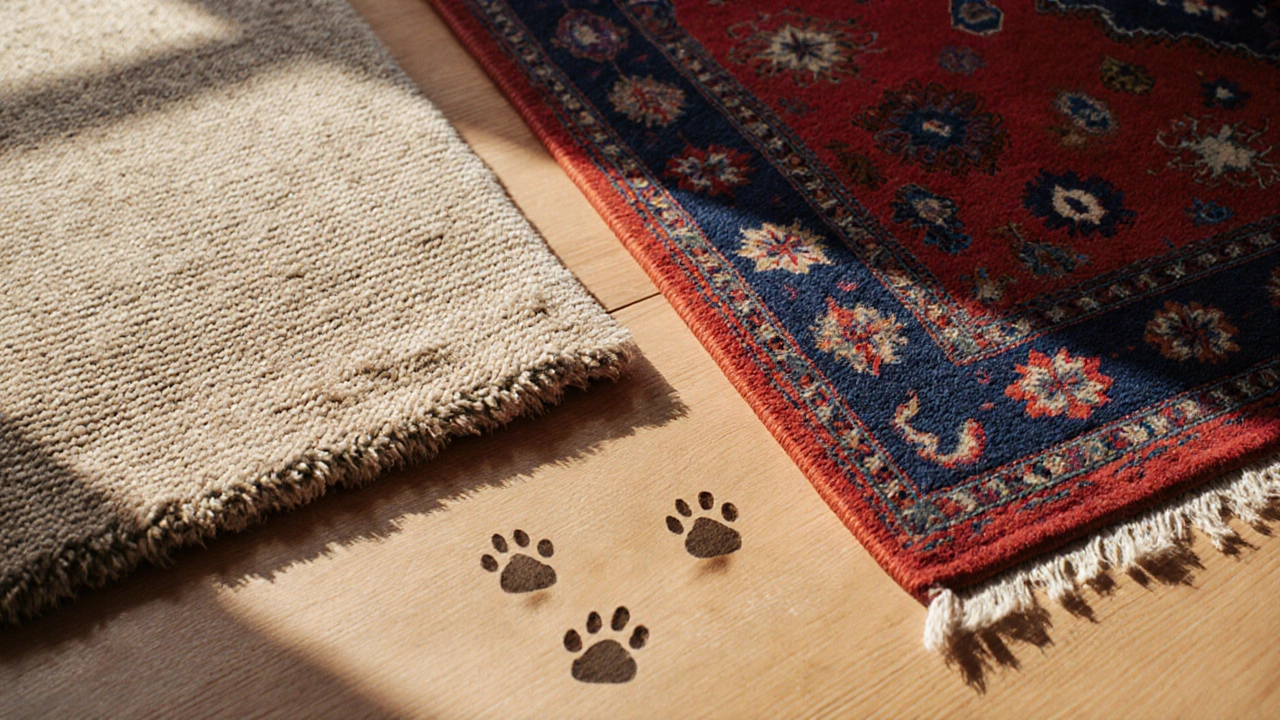Rug Cost Calculator
Calculate Your Rug Value
Determine if your rug offers good value by calculating cost per square foot.
Ever walked into a store and seen a rug that looked perfect-until you checked the price? Then you wondered: is this really worth it? Or are you just paying for a brand name? The truth is, a good rug doesn’t have a single price tag. It depends on what you’re getting, where it’s made, and how long you plan to live with it. A $50 rug from a big-box store might look fine today, but after a year of foot traffic, pets, or sunlight, it could be flat, faded, and fraying. A $500 rug, on the other hand, could last two decades and still look beautiful. So how much should you actually spend?
What Makes a Rug "Good"?
A good rug isn’t just about looks. It’s about how it holds up. The best rugs are made with durable materials, tight weaves, and natural dyes. Wool is the gold standard-it’s naturally stain-resistant, resilient underfoot, and biodegradable. Cotton is softer but less durable, often used for flatweaves or as a backing. Synthetic fibers like nylon or polyester are cheaper and easy to clean, but they don’t breathe the same way wool does, and they can look plasticky over time.
Construction matters too. Hand-knotted rugs, especially from places like Iran, India, or Nepal, take hundreds or even thousands of hours to make. Each knot is tied by hand, and the tighter the knot count (measured in knots per square inch), the finer and longer-lasting the rug. A high-quality hand-knotted rug can have 100-400 knots per square inch. Machine-made rugs are faster and cheaper, but they often lack depth and character. You can tell the difference by flipping it over: hand-knotted rugs show the same pattern on the back, while machine-made ones have a uniform, often glued, backing.
Price Ranges Explained
Rug prices vary wildly, but here’s what you’ll actually get at different price points:
- $20-$100: These are usually thin, machine-made rugs from mass producers. Often made with polypropylene or recycled polyester. They’re fine for low-traffic areas like a bedroom or a home office, but they won’t last more than 2-3 years if used daily. Don’t expect colorfastness or softness.
- $100-$300: This is where you start seeing better construction. Many in this range are power-loomed wool blends or cotton flatweaves. They’re durable enough for living rooms or hallways. Brands like IKEA, Wayfair, and Rugs USA have solid options here. A 5x8 rug in this range might last 5-8 years with regular care.
- $300-$800: This is the sweet spot for most households. You’re getting 100% wool, tighter weaves, and often hand-tufted or hand-hooked construction. These rugs hold their shape, resist shedding, and have richer colors. A well-made 8x10 rug in this range can easily last 10-15 years. Many are made in India or Turkey using traditional techniques.
- $800-$2,000+: These are hand-knotted rugs, often from Persian, Caucasian, or Tibetan weavers. They’re heirloom pieces. A 6x9 hand-knotted wool rug with 200+ knots per square inch can cost $1,200-$2,500. These aren’t just floor coverings-they’re art. They appreciate in value and can be passed down.
Remember: size matters. A $500 rug might sound expensive, but if it’s 9x12, that’s less than $5 per square foot. A $150 rug that’s only 5x7 is over $4 per square foot. Always calculate cost per square foot to compare fairly.
Where You Buy Matters
Not all retailers are created equal. Big-box stores like Target or Walmart sell rugs designed for quick turnover. They’re cheap to produce and often use low-grade materials. You’ll find the same rug online for less, but you’re still paying for mass production.
Specialty rug shops, whether local or online, focus on quality and transparency. They’ll tell you where the rug was made, what materials were used, and whether it’s handcrafted. Places like Rug & Home a UK-based retailer specializing in handwoven wool rugs with transparent sourcing or The Rug Company a British brand known for high-end, designer hand-knotted rugs offer detailed product histories. You might pay more upfront, but you’re investing in something built to last.
Online marketplaces like Etsy or Chairish have thousands of handmade rugs from small artisans. Prices vary, but you can often find unique, smaller rugs for under $500 that are genuinely handcrafted. Just check reviews carefully-look for photos of the rug in real homes, not just studio shots.

What You’re Really Paying For
When you buy a rug, you’re not just buying floor covering. You’re paying for:
- Material quality: Wool lasts longer than synthetics and ages gracefully.
- Labour: A single hand-knotted rug can take a weaver 3-6 months to finish. That time is reflected in the price.
- Dyes: Natural dyes from plants and insects create richer, more complex colors that fade slowly. Chemical dyes fade faster and can bleed.
- Design: Unique patterns, cultural motifs, and custom sizing add value. A rug designed by an artist costs more than a generic geometric print.
- Longevity: A $1,000 rug that lasts 20 years costs $50 a year. A $200 rug that wears out in 4 years costs $50 a year too-but you’re replacing it four times.
Think of it like buying shoes. You can get a $40 pair that falls apart in six months, or a $200 pair that lasts five years. The total cost over time is similar, but one keeps you comfortable, looks better, and doesn’t waste money.
How to Know You’re Getting a Good Deal
Here’s how to spot value, not just low prices:
- Check the backing: Flip the rug. If you can see the knots clearly and they’re even, it’s hand-knotted. If the back is covered in glue or a mesh, it’s machine-made.
- Smell it: New synthetic rugs often have a strong chemical odor. Wool smells like nothing-or like a clean, earthy wool sweater.
- Ask about origin: Reputable sellers will say where it was made. If they say "imported" without details, be skeptical.
- Look for color variation: Hand-dyed rugs have slight variations in shade. Perfect uniformity means machine dyeing.
- Test the pile: Rub your hand over the surface. If fibers pull out easily, it’s low quality. Good wool resists shedding after the first few vacuumings.
Also, check return policies. A good rug seller will let you return it if it doesn’t work in your space. Some even offer free samples so you can see the color in your light.

When to Splurge and When to Save
Not every rug needs to be an heirloom. Here’s how to spend wisely:
- Splurge on: The main living room rug. It’s the centerpiece. You sit on it, walk on it daily, and guests notice it. Invest here.
- Save on: Bedroom rugs. You’re not walking on them as much. A mid-range cotton or wool blend works fine.
- Save on: High-traffic entryways. Use a durable, machine-made rug with a non-slip pad underneath. You’ll replace it sooner anyway.
- Splurge on: Rugs in homes you plan to live in for 10+ years. They become part of your space.
- Save on: Rugs for rentals or short-term stays. Go for affordable, easy-to-clean options.
What You Shouldn’t Do
Don’t buy a rug without a pad. A good rug pad prevents slipping, reduces wear, and adds cushion. It’s a $30-$100 investment that doubles your rug’s life.
Don’t assume a higher price always means better quality. Some brands inflate prices with marketing, not craftsmanship. Always compare materials and construction, not just labels.
Don’t rush. Good rugs take time to find. Visit a local rug store, lie on the floor with a few options, and see how they look at different times of day. Light changes everything.
Final Rule of Thumb
Here’s a simple formula: spend at least $100 per square meter if you want a rug that lasts more than five years. For a standard 8x10 rug (about 7.4 square meters), that’s $740. It’s not a guarantee, but it’s a solid starting point for quality. If you can stretch to $150 per square meter, you’re in heirloom territory.
At the end of the day, a good rug isn’t about how much you spend-it’s about how well it serves you. The right one feels solid underfoot, looks better over time, and doesn’t make you feel like you wasted money. That’s worth paying for.
Is a $200 rug worth buying?
Yes-if it’s made of wool, has a tight weave, and you’re using it in a low-traffic area like a bedroom. A $200 rug from a reputable brand can last 5-8 years with proper care. But avoid cheap synthetics at this price point-they’ll flatten and fade fast.
Why are Persian rugs so expensive?
Persian rugs are hand-knotted with high knot counts, often using wool from local sheep and natural dyes. A single rug can take a weaver 6-18 months to complete. The craftsmanship, cultural heritage, and material quality make them rare and valuable. They’re not just rugs-they’re textiles with centuries of tradition behind them.
Can you wash a good rug at home?
Most quality rugs shouldn’t be washed at home. Wool rugs can shrink or felt if soaked improperly. Spot clean spills with a damp cloth and mild soap. For deep cleaning, hire a professional rug cleaner who understands natural fibers. Never use a steam cleaner on a hand-knotted rug.
Do expensive rugs hold their value?
Hand-knotted, antique, or designer rugs can appreciate over time, especially if they’re well-maintained. A 1970s Persian rug bought for $1,000 might now be worth $3,000-$5,000. But most modern rugs, even expensive ones, depreciate like furniture. Buy for beauty and use, not as an investment.
What’s the best rug for pets?
A low-pile, tightly woven wool rug is ideal. It hides fur and resists stains better than plush or synthetic rugs. Darker colors or busy patterns help mask accidents. Avoid silk or very fine wool-pets’ claws can snag them. Always use a non-slip pad to prevent sliding.
If you’re still unsure, start with a mid-range wool rug in your budget. Test it for a few months. See how it holds up to daily life. If it still looks and feels good after a year, you’ve made the right choice. The best rug isn’t the most expensive one-it’s the one you don’t want to replace.

